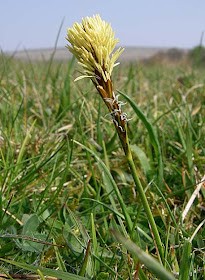Field maple Acer campestre flowers are produced at the same time as the leaves in Spring, like sycamore but unlike Norway maple that opens its flower buds before the leaves expand. They point upwards, unlike sycamore flowers that dangle.
Unlike those other two Acer species, the green petals of the flowers are covered with long hairs. Field maple also produces a lot of nectar (you can see the drops glistening here, especially if you double-click on the image to enlarge) and this attracts small flies that pollinate the flowers. There are eight stamens and a stigma that's divided into two branches.
Oak catkins are produced at the same time as the leaves expand in April. These are male catkins that will release pollen - the female ones that will produce acorns are much shorter, with just a few florets.
Sweet chestnut in full flower, showing the long male catkins. These are produced well after the leaves have fully expanded, in July. This means there's not much time before autumn for the fruits to develop - which is why we never get much of a crop here in North East England unless we get a long, mild autumn.
The stamens on the make catkin of sweet chestnut. The male flowers have a sickly smell.
Limes (Tilia spp.) are relatively late bloomers too, opening right at the end of June. They dangle from long stalks that have a single elongated wing attached, that later slows the fall of the seeds and aids their dispersal. Lime flowers produce large amounts of nectar and if you stand underneath a tree when it's in full bloom it literally hums with bumblebees, that find it irresistible.




















































